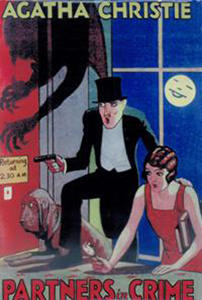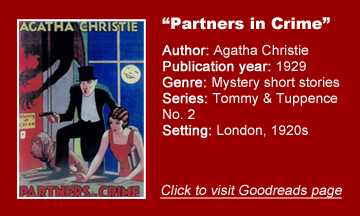Agatha Christie returns to her husband-and-wife sleuths from 1922’s “The Secret Adversary” with the episodic short-story collection “Partners in Crime” (1929), a light batch of cutesy mysteries that originally appeared in magazines.
A quippy couple
Blending “Thin Man”-style quips between Tommy and Tuppence Beresford, a boatload of references to other fictional detectives, and cases that lean toward the simpler side, “Partners in Crime” is a series of snacks rather than a hearty meal. I personally would select a Poirot or Marple book first, but for who they are, I don’t dislike T&T.
The couple solves cases from their offices at the International Detective Agency in London, pretending to be Mr. Blunt and his confidential secretary, Miss Robinson.
Chief Carter, from the secret service (where Tommy has a low-level job), sets them up with this borderline-legitimate agency as a way to catch an international criminal in the last of the 14 shorts (spread over 23 chapters, as some cover two chapters). In the meantime, though, T&T get to solve real cases and make some dough.
If I knew more about detective fiction, I would likely appreciate “Partners in Crime” more, but it is accessible even if the depth of your knowledge only extends to Sherlock Holmes/Watson and Christie’s own Poirot/Hastings (who are cheekily referenced early on and then referenced as real people in this world later on).
The couple sees this all as a game, taking on the personas of fictional sleuthing pairs on each case. More broadly, we get a peek into business tricks when T&T pretend to have a thriving office, not merely three employees (Albert, who mans the front desk, is the third).
The stakes are rarely high, and even when they approach life-and-death situations, Tommy and Tuppence never see the stakes as being high. It’s impossible for a reader to sink deep into the book because its appeal is purposely on the surface.
Running joke
I don’t hold this against the couple themselves, as they are likable. Christie is nominally showing amateur detectives gradually improving, but she also tries for a running joke that they are miraculously, naturally good at their jobs. There’s also the briefest hint that T&T represent Christie’s lower-monetary-class detectives, but the agency becomes successful quickly enough that funds are a non-issue, as with Poirot.
One thing we can say for sure is that Tommy and Tuppence represent Christie’s young, spunky detectives, as Tommy is about 30 and Tuppence slightly younger. By comparison, Poirot is (supposedly) retired in his very first book and Miss Marple doesn’t exactly do a lot of legwork in tracking down culprits, either.
T&T’s personalities are well written, with Tommy being slightly more pragmatic and Tuppence slightly more impulsive – but they vary, partly because of all the play-acting. As they trade barbs and occasionally let slip that they care about each other, Tommy and Tuppence contribute equally to the solving of crimes, and view it as a grand ole time.

(Although contributing equally, Tommy always plays the role of the agency boss, no doubt owing to clients’ expectations at the time that a male be in charge.)
Dashiell Hammett would later run with the “couple solving crimes” archetype, inventing Nick and Nora Charles in 1934. The Charleses have more of a following than the Beresfords, although the latter have their share of radio and screen adaptations too.
That said, my degree of liking of a given short story isn’t dependent on T&T’s quips or ingenuity, but rather on the quality of Christie’s mystery plotting. She’s on her game in some chapters, remarkably off it in others.
Hit-and-miss endings (Spoilers)
(SPOILERS FOLLOW.)
“Partners in Crime” includes a story of one woman having two unbreakable alibis where the solution is that she has a twin. As soon as T&T started down the path on this one, I thought “Well, the obvious answer is that the woman has a twin, but the obvious is never the case in detective fiction, especially if the writer is Christie.” But it is here, and it made me feel like I had read a young-adult story.
In another yarn, a missing woman turns out to have checked into a weight-loss clinic. It’s a commentary on her desire to please her husband, I suppose, but it’s a rather flat conclusion.
Granted, Christie is not necessarily trying and failing to come up with great surprises in these instances. She’s commenting on the detective-fiction genre, saying “What if sometimes the cases ended up without surprises?” So, if one wants to be generous, these stories have a certain cheeky quality.
And it’s not like she settles on bland, likely answers every time. The standout is “The Sunningdale Mystery,” a golf course-set tale in which we must seriously exercise our little grey cells to work through switched identities and hidden motives.
Through two books, I’m impressed with the concept of Tommy & Tuppence more so than the cases they work on, but I won’t cringe when I get to the next of their five books.
Every week, Sleuthing Sunday reviews an Agatha Christie book or adaptation. Click here to visit our Agatha Christie Zone.


